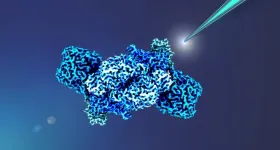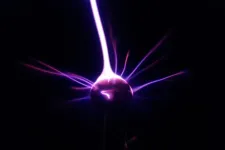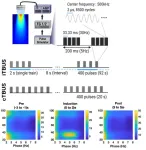(Press-News.org) An international team, including researchers from McMaster University and St. Joseph’s Healthcare Hamilton, has identified a new therapeutic for patients with a rare autoimmune disease called eosinophilic granulomatosis with polyangiitis (EGPA). A biologic drug called benralizumab has been shown to be non-inferior to mepolizumab in the treatment of EGPA.
In a clinical trial involving 140 patients with the rare disease, researchers directly compared two biologic drugs, mepolizumab and benralizumab. Patients received monthly subcutaneous injections of either 300 mg of mepolizumab or 30 mg of benralizumab for one year. The findings of the trial were published on Feb. 23, 2024, in the New England Journal of Medicine.
“Our findings show that benralizumab was just as effective as mepolizumab at reducing exacerbations and providing disease remission during the 52 weeks of the study,” says Parameswaran Nair, a professor with McMaster’s Department of Medicine and a respirologist at St. Joe’s Firestone Institute for Respiratory Health.
Nair was one of the study’s principal investigators who led the Canadian team. He worked closely with Nader Khalidi, a professor with McMaster’s Department of Medicine and a rheumatologist with St. Joe’s, to design the study and recruit patients.
“The single 30 mg subcutaneous dosing of benralizumab offers an advantage to patients over the three 100 mg subcutaneous dosing of mepolizumab,” says Nair.
EGPA, also known as Churg-Strauss Syndrome, is a rare autoimmune disease caused by inflammation of small and medium sized blood vessels and is associated with very high blood and tissue eosinophil counts. This can lead to damage of the lungs, skin, heart, gastrointestinal tract, and nerves. Most patients with EGPA experience breathing and lung issues.
The researchers noted that approximately 16 per cent more patients in the benralizumab group were able to abstain from using oral corticosteroids compared to the mepolizumab group. Typically, patients with EGPA use oral corticosteroids like prednisone for symptom control despite the adverse effects.
“Without biologics, we’re relying predominantly on oral corticosteroids to control EGPA symptoms. Prolonged treatment with prednisone reduces the risk of a relapse of EGPA symptoms, but it comes with progressive toxic effects,” says Khalidi. “In our study, treatment with benralizumab allowed more patients to discontinue prednisone over a 52-week period compared to mepolizumab.”
Mepolizumab and benralizumab are biologic drugs. Biologics are a class of drugs that come from living organisms or from their cells, often made using biotechnology.
The two biologics used in this study work by targeting either the signals or the receptors of eosinophils, a type of immune cell that is found in high concentrations in the blood and tissue of EGPA patients. By blocking the signals or receptors that draw eosinophils into various tissues, such as the lungs, mepolizumab and benralizumab effectively decrease eosinophils, reducing symptoms.
“Benralizumab was associated with greater blood eosinophil depletion than mepolizumab from week one onwards,” says Nair. “Both drugs were well tolerated without any new adverse events.”
The study builds on a long history of research on eosinophilic conditions from the Firestone Institute for Respiratory Health at St. Joe’s. Pioneering work into the study of severe eosinophilic asthma by Freddy Hargreave led to a method for enumerating eosinophils in sputum samples for accurate asthma diagnoses.
For patients with severe prednisone-dependent asthma, Hargreave, Nair, and their colleagues were the first to demonstrate the efficacy of mepolizumab in 2009. By 2017, Nair had further demonstrated the efficacy of benralizumab for the same condition. Both landmark studies were published in the New England Journal of Medicine.
“It is very gratifying that our research program at the Firestone Institute at St. Joe’s has led to the development of these new treatment options for patients with severe eosinophilic diseases,” Nair says.
Funding for this study was provided by AstraZeneca.
To speak with researcher Nader Khalidi, you can reach out to him directly at khalidn@mcmaster.ca
END
Researchers identify new choice of therapy for rare autoimmune disease EGPA
2024-02-23
ELSE PRESS RELEASES FROM THIS DATE:
Powering nitrogenases
2024-02-23
Nitrogenases are considered promising candidates for the sustainable enzymatic production of ammonia and carbon compounds. Unfortunately, one bottleneck in this complex process, the supply of electrons to the enzymes, has remained a mystery until now. Now a team at the Max Planck Institute for Terrestrial Microbiology in Marburg has discovered two essential electron carriers which play a key role in determining the performance of iron (Fe) nitrogenase, thus opening up new possibilities for elucidating and maximizing nitrogenase's potential.
Nitrogenases are catalysts for several industrially relevant ...
NJIT marketing experts measure brain waves and skin current to predict emotions
2024-02-23
Machines still can’t think, but now they can validate your feelings, based on new research from New Jersey Institute of Technology Assistant Professor Jorge Fresneda.
Fresneda started his career as a chemist and then became an expert in neuroanalytics. He studies how measurements of brain activity and skin conductance can predict a person’s emotions with high accuracy, and how such information can be used in fields such as entertainment, management, marketing and well-being.
“Neuromarketing is a subfield within marketing ...
Babies use immune system differently, but efficiently
2024-02-23
ITHACA, N.Y. – Scientists have long believed that a newborn’s immune system was an immature version of an adult’s, but new research from Cornell University shows that newborns’ T cells – white blood cells that protect from disease – outperform those of adults at fighting off numerous infections.
These results help clarify why adults and infants respond differently to infections and pave the way for controlling T cells’ behavior for therapeutic applications.
This discovery was described in a paper published in Science Immunology on Feb. 23, co-led by Brian Rudd, associate professor of microbiology ...
Cloud clustering causes more extreme rain
2024-02-23
Understanding cloud patterns in our changing climate is essential to making accurate predictions about their impact on society and nature. Scientists at the Institute of Science and Technology Austria (ISTA) and the Max-Planck-Institute for Meteorology published a new study in the journal Science Advances that uses a high-resolution global climate model to understand how the clustering of clouds and storms impacts rainfall extremes in the tropics. They show that with rising temperatures, the severity of extreme precipitation events increases.
Extreme ...
Mindfulness at work protects against stress and burnout
2024-02-23
A new study has revealed that employees who are more mindful in the digital workplace are better protected against stress, anxiety and overload.
Researchers from the University of Nottingham’s Schools of Psychology and Medicine analysed survey data from 142 employees. The results have been published today in PLOS ONE.
PhD student Elizabeth Marsh from the School of Psychology led the mixed methods study and said: “As work is increasingly mediated by digital technology we wanted to find out the impact this is having on people’s health and whether there are ways to mitigate this. We found that being mindfully and confidently digital should be considered important elements ...
Scientists closer to solving mysteries of universe after measuring gravity in quantum world
2024-02-23
Scientists are a step closer to unravelling the mysterious forces of the universe after working out how to measure gravity on a microscopic level.
Experts have never fully understood how the force which was discovered by Isaac Newton works in the tiny quantum world.
Even Einstein was baffled by quantum gravity and, in his theory of general relativity, said there is no realistic experiment which could show a quantum version of gravity.
But now physicists at the University of Southampton, working with scientists in Europe, have ...
Revolutionary brain stimulation technique shows promise for treating brain disorders
2024-02-23
The human brain's adaptability to internal and external changes, known as neural plasticity, forms the foundation for understanding cognitive functions like memory and learning, as well as various neurological disorders. New research conducted by a team led by Dr. PARK Joo Min of the Center for Cognition and Sociality within the Institute for Basic Science (IBS) unveils a novel technique that could transform the treatment landscape for brain disorders. The team developed a non-invasive brain stimulation method called Patterned Low-Intensity Low-Frequency Ultrasound (LILFUS), which holds tremendous potential for inducing long-lasting changes ...
Global warming increases the diversity of active soil bacteria
2024-02-23
Warmer soils harbour a greater diversity of active microbes, according to a new study from researchers at the Centre for Microbiology and Environmental Systems Science (CeMESS) at the University of Vienna. The study, published in Science Advances, represents a significant shift in our understanding of how microbial activity in the soil influences the global carbon cycle and possible feedback mechanisms on the climate. Until now, scientists have assumed that higher soil temperatures accelerate the growth of microbes, thus increasing the release of carbon into the atmosphere. However, this increased ...
Patient mindset training helps care teams
2024-02-23
A new study from Stanford University, published Jan. 19 in Patient Education and Counseling, evaluates the effectiveness of patient mindset training on provider learning and behavior.
Past research shows that what patients think, believe, or expect regarding medical care can influence care outcomes. Patients also have better outcomes when they have more adaptive mindsets about their treatments (e.g., “this treatment will be effective”), their bodies (e.g., “my body is capable”), their illnesses (e.g. “diabetes is manageable”), and their care team (e.g., “I am in good hands”). ...
Dual-energy harvesting device could power future wireless medical implants
2024-02-23
UNIVERSITY PARK, Pa. — Implantable biomedical devices — like pacemakers, insulin pumps and neurostimulators — are becoming smaller and utilizing wireless technology, but hurdles remain for powering the next-generation implants. A new wireless charging device developed by Penn State scientists could dramatically improve powering capability for implants while still being safe for our bodies, the researchers said.
The new device can harvest energy from magnetic field and ultrasound sources simultaneously, converting this energy to electricity to power implants, the scientists reported in the journal Energy & Environmental ...






